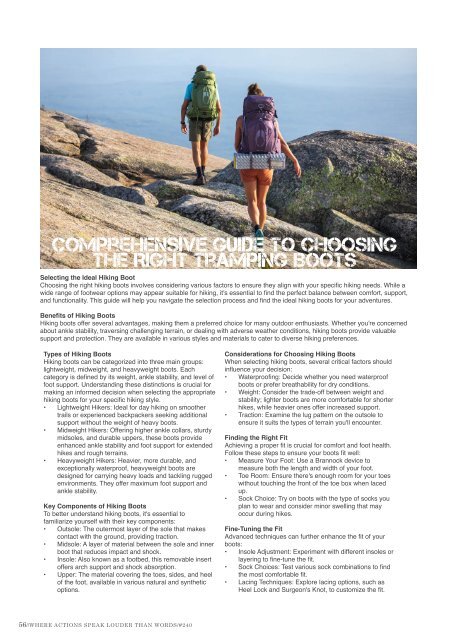Adventure Magazine
Camping and tramping issue
Camping and tramping issue
Create successful ePaper yourself
Turn your PDF publications into a flip-book with our unique Google optimized e-Paper software.
Comprehensive Guide to Choosing<br />
the Right Tramping Boots<br />
Selecting the Ideal Hiking Boot<br />
Choosing the right hiking boots involves considering various factors to ensure they align with your specific hiking needs. While a<br />
wide range of footwear options may appear suitable for hiking, it's essential to find the perfect balance between comfort, support,<br />
and functionality. This guide will help you navigate the selection process and find the ideal hiking boots for your adventures.<br />
Benefits of Hiking Boots<br />
Hiking boots offer several advantages, making them a preferred choice for many outdoor enthusiasts. Whether you're concerned<br />
about ankle stability, traversing challenging terrain, or dealing with adverse weather conditions, hiking boots provide valuable<br />
support and protection. They are available in various styles and materials to cater to diverse hiking preferences.<br />
Types of Hiking Boots<br />
Hiking boots can be categorized into three main groups:<br />
lightweight, midweight, and heavyweight boots. Each<br />
category is defined by its weight, ankle stability, and level of<br />
foot support. Understanding these distinctions is crucial for<br />
making an informed decision when selecting the appropriate<br />
hiking boots for your specific hiking style.<br />
• Lightweight Hikers: Ideal for day hiking on smoother<br />
trails or experienced backpackers seeking additional<br />
support without the weight of heavy boots.<br />
• Midweight Hikers: Offering higher ankle collars, sturdy<br />
midsoles, and durable uppers, these boots provide<br />
enhanced ankle stability and foot support for extended<br />
hikes and rough terrains.<br />
• Heavyweight Hikers: Heavier, more durable, and<br />
exceptionally waterproof, heavyweight boots are<br />
designed for carrying heavy loads and tackling rugged<br />
environments. They offer maximum foot support and<br />
ankle stability.<br />
Key Components of Hiking Boots<br />
To better understand hiking boots, it's essential to<br />
familiarize yourself with their key components:<br />
• Outsole: The outermost layer of the sole that makes<br />
contact with the ground, providing traction.<br />
• Midsole: A layer of material between the sole and inner<br />
boot that reduces impact and shock.<br />
• Insole: Also known as a footbed, this removable insert<br />
offers arch support and shock absorption.<br />
• Upper: The material covering the toes, sides, and heel<br />
of the foot, available in various natural and synthetic<br />
options.<br />
Considerations for Choosing Hiking Boots<br />
When selecting hiking boots, several critical factors should<br />
influence your decision:<br />
• Waterproofing: Decide whether you need waterproof<br />
boots or prefer breathability for dry conditions.<br />
• Weight: Consider the trade-off between weight and<br />
stability; lighter boots are more comfortable for shorter<br />
hikes, while heavier ones offer increased support.<br />
• Traction: Examine the lug pattern on the outsole to<br />
ensure it suits the types of terrain you'll encounter.<br />
Finding the Right Fit<br />
Achieving a proper fit is crucial for comfort and foot health.<br />
Follow these steps to ensure your boots fit well:<br />
• Measure Your Foot: Use a Brannock device to<br />
measure both the length and width of your foot.<br />
• Toe Room: Ensure there's enough room for your toes<br />
without touching the front of the toe box when laced<br />
up.<br />
• Sock Choice: Try on boots with the type of socks you<br />
plan to wear and consider minor swelling that may<br />
occur during hikes.<br />
Fine-Tuning the Fit<br />
Advanced techniques can further enhance the fit of your<br />
boots:<br />
• Insole Adjustment: Experiment with different insoles or<br />
layering to fine-tune the fit.<br />
• Sock Choices: Test various sock combinations to find<br />
the most comfortable fit.<br />
• Lacing Techniques: Explore lacing options, such as<br />
Heel Lock and Surgeon's Knot, to customize the fit.<br />
56//WHERE ACTIONS SPEAK LOUDER THAN WORDS/#240
















